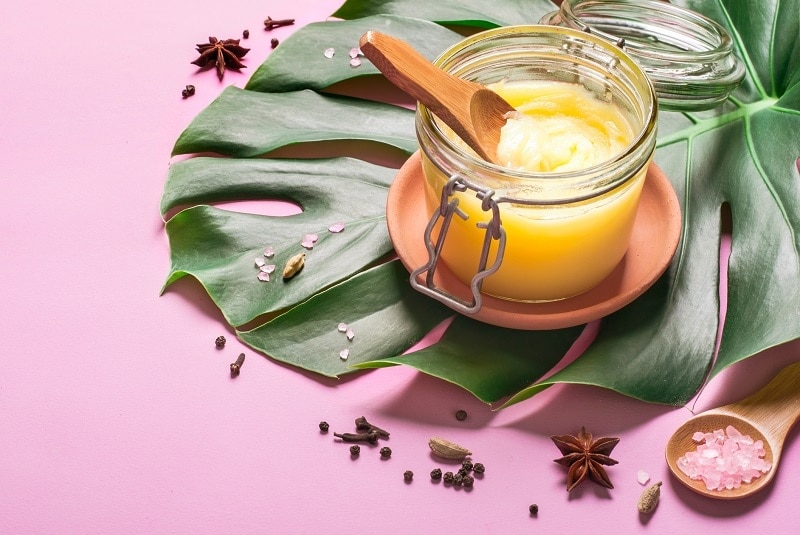You may have heard all about ghee from your friend who has been making Indian or Asian dishes or your friend who is looking to decrease dairy in their diet. Ghee is traditionally used in Indian cuisine and has been a staple in many cultures for thousands of years. Here’s the down-low on what ghee is.
What is ghee?
It’s a form of butter made from cow’s milk and is highly clarified. Clarification of this butter entails a process in which the milk solids are removed, and only liquid fat remains. This may sound like an overwhelming process but read further to see how you can make this yourself and include it in everyday cooking! Ghee is rich, nutty in flavor and an appealing option for many different reasons. Let’s dive a little deeper and discover the greatness of ghee.
Ghee vs. butter
Ghee is made by slowly melting butter over time and the simmering on low until the milk solids land to the bottom of the pan. Once separated, the oil left is strained through a filter leaving you with a rich and bold oil, which solidifies at room temperature.
Unlike butter, ghee can be kept at room temperature for 2-3 months without spoiling. Ghee is more shelf-stable than butter because it has been cooked for a longer period. This makes it the ideal candidate to spread on toast or potatoes for some instant melting action.
Having removed the milk solids during the cooking process, ghee has a higher smoke-point of 485 degrees F compared to butter’s, which is 350 degrees F. This makes ghee perfect for roasting or sautéing your favorite vegetables or sources of protein.
Overall, ghee consists solely of fat. About 65 percent comes from saturated fat, 30 percent monounsaturated fat and 5 percent polyunsaturated fat. The American Heart Association recommends limiting saturated fat to less than 10 percent of total daily calories. Keeping that in mind, ghee should only be consumed in small amounts similarly to butter. Ghee has benefits known of helping our bodies absorb fat soluble vitamins, A, K, E and D.
Those who are lactose intolerant may find a great alternative to butter within ghee. Since the milk solids are removed, ghee is a friendly option if dairy causes stomach issues. Friendly note to those who know they have a dairy allergy (including casein and whey), ghee is not 100 percent dairy-free. Depending on your level of sensitivity, if you’re looking to buy ghee at the store or online at Vitacost.com, we recommend checking with the producer as some have stated that there are trace amounts of lactose found in their products.
How to make ghee
If you’re looking to get in the kitchen then we’ve got the recipe to make your own ghee at home!
We recommend using unsalted butter sticks to create your ghee. Melt butter over low heat until the milk solids land to the bottom and are left behind not to be consumed. At this point, you will have a rich golden liquid that has risen to the top. Then gently simmer the butter until the water has evaporated and the milk solids become a golden-brown color. Keep an eye on this as you don’t want the milk solids to burn. This step is where the full-bodied color and nutty flavors are truly developed and enrichened.
Finally, carefully strain the ghee through an ultra-fine cheesecloth to separate your ghee from the remaining solids. We recommend pouring ghee over a bowl or measuring cup and then placing into glass containers. Once you’ve placed your golden liquid into a container, it will solidify at room temperature like butter.
How to use ghee
Here are a few simple ways to incorporate ghee into your diet:
- Mix with herbs to create a rub for chicken
- Create a hot sauce at home using ghee as your base
- Incorporate into your favorite casserole
- Sauté onions and bell peppers in ghee for a tasty taco night
- Spread on toast
- Add to rice once cooked
- Drizzle onto popcorn
Remember, we want to make sure to regulate the quantity of ghee eaten daily so portion control is key. Servings should be between ½-1 tablespoon a day. Happy cooking!
For delicious recipes that call for ghee, such as coconut-glazed Mexican street corn, grain-free rhubarb crumble and chocolate chip collagen protein balls, click here.

